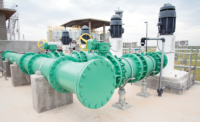The George W. Shannon Wetlands Water Recycling Facility at Richland-Chambers Reservoir serves as an important component in Tarrant Regional Water District's water supply system. TRWD serves more than 1.8 million customers across 11 counties in the Dallas-Fort Worth area and is expected to increase the water supply by 30% from the Richland-Chambers Reservoir to serve 4.3 million customers by 2060.

The project diverts Trinity River water, which can be dominated by highly treated wastewater return flows from the Dallas-Fort Worth Metroplex, into Richland-Chambers Reservoir to provide additional raw water supply.
The wetland system acts as a "living" filter that is efficient at removing phosphorus, nitrogen and other nutrients, thus enhancing water quality and protecting the receiving reservoir.
With the final build-out of the phase two expansion completed in late 2013, the 1,880-acre facility is now the second-largest constructed wetlands in the U.S.
The scope of this man-made wetlands included construction of 34 miles of earthen levees to create five sedimentation basins and 20 wetland cells, five miles of inter-basin canals and 54 concrete inflow-outflow and spillway control structures.
The project required more than 2 million cu yd of earthwork on a 2,200-acre site that is situated entirely within a one-year floodplain.
The CM at-risk delivery method allowed McCarthy to get involved in the project early. During preconstruction, the team realized the high potential for a major flood during spring and fall that could significantly delay the project for months at a time. Before the guaranteed maximum price submission in 2009, TRWD and McCarthy jointly toured the site of a major flood to understand the impact that such an event could have on construction operations.
The project team realized the best way to reduce the direct cost of work and avoid inflated bids was to reduce the risk to subcontractors for delays and demobilization during floods by removing cost liability to them. So, working with TRWD, Alan Plummer and Associates and program manager CH2M Hill, the contractor developed project contracts and specifications that defined clear allowances and risk-sharing strategies such as increased contingencies to account for such an event. These measures mitigated risks and resulted in more competitive subcontractor bids.
During the project, McCarthy encountered two major floods that severely affected progress. In order to minimize damage from flood waters, subcontractors built temporary earthen dams, temporary drainage canals and resequenced their work to build the outside perimeter levees first.
The project staff monitored and documented the levels of the Trinity River by using local staff gauges, National Oceanic and Atmospheric Administration river hydrographs and TRWD spillway discharge rates to predict floods days in advance.
This allowed the team to notify subcontractors about impending weather problems, which helped them move equipment and materials to high ground. Allowances were set aside specifically in the GMP to assist subs with damage from floods.
In the end, McCarthy was able to deliver the project on schedule and $5.4 million under budget.
Key Players
General Contractor McCarthy Building Cos., Dallas
Owner Tarrant Regional Water District, Fort Worth
Lead Design/Structural/Civil Alan Plummer Associates Inc., Dallas
MEP CH2M Hill, Dallas






